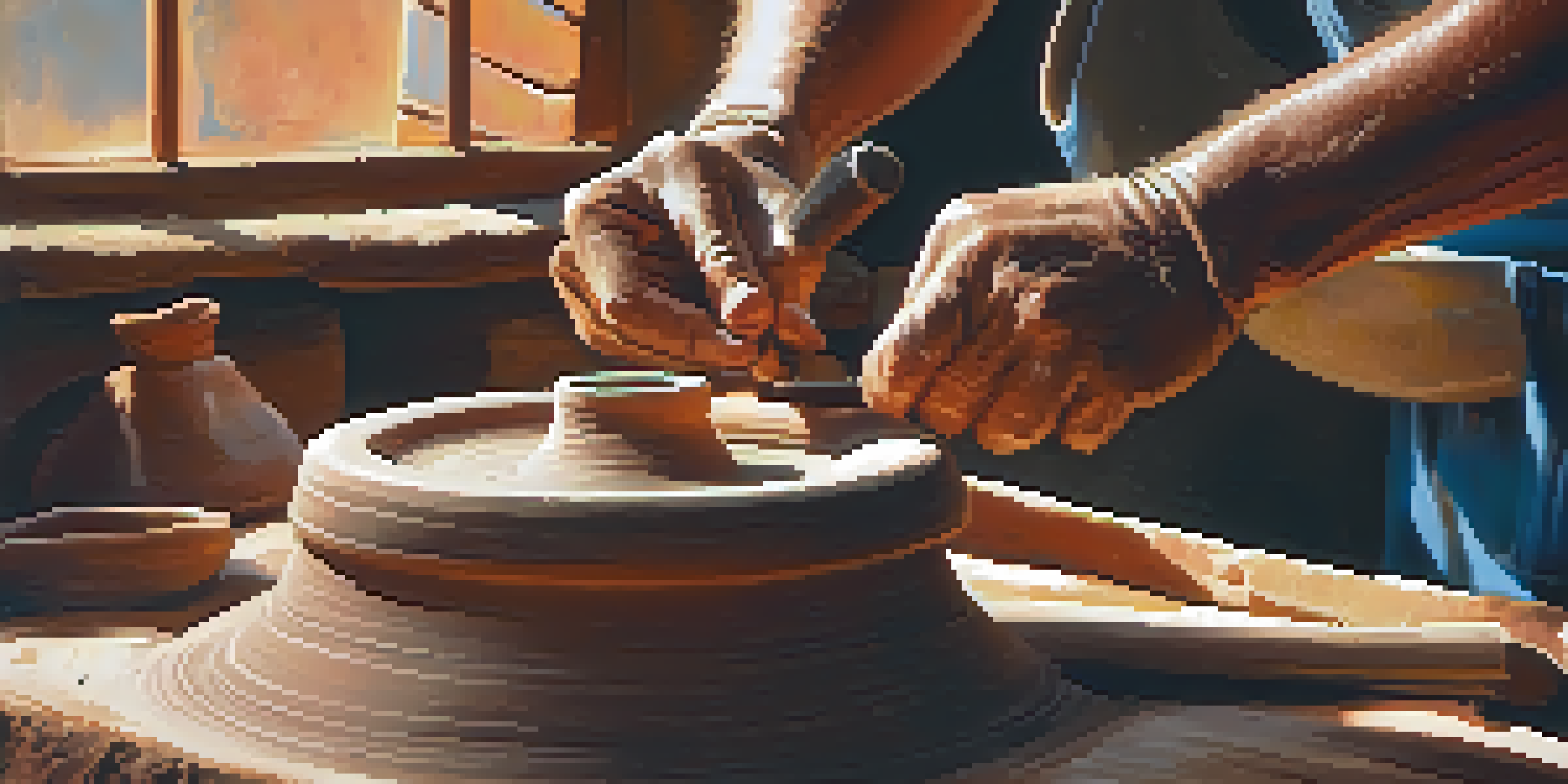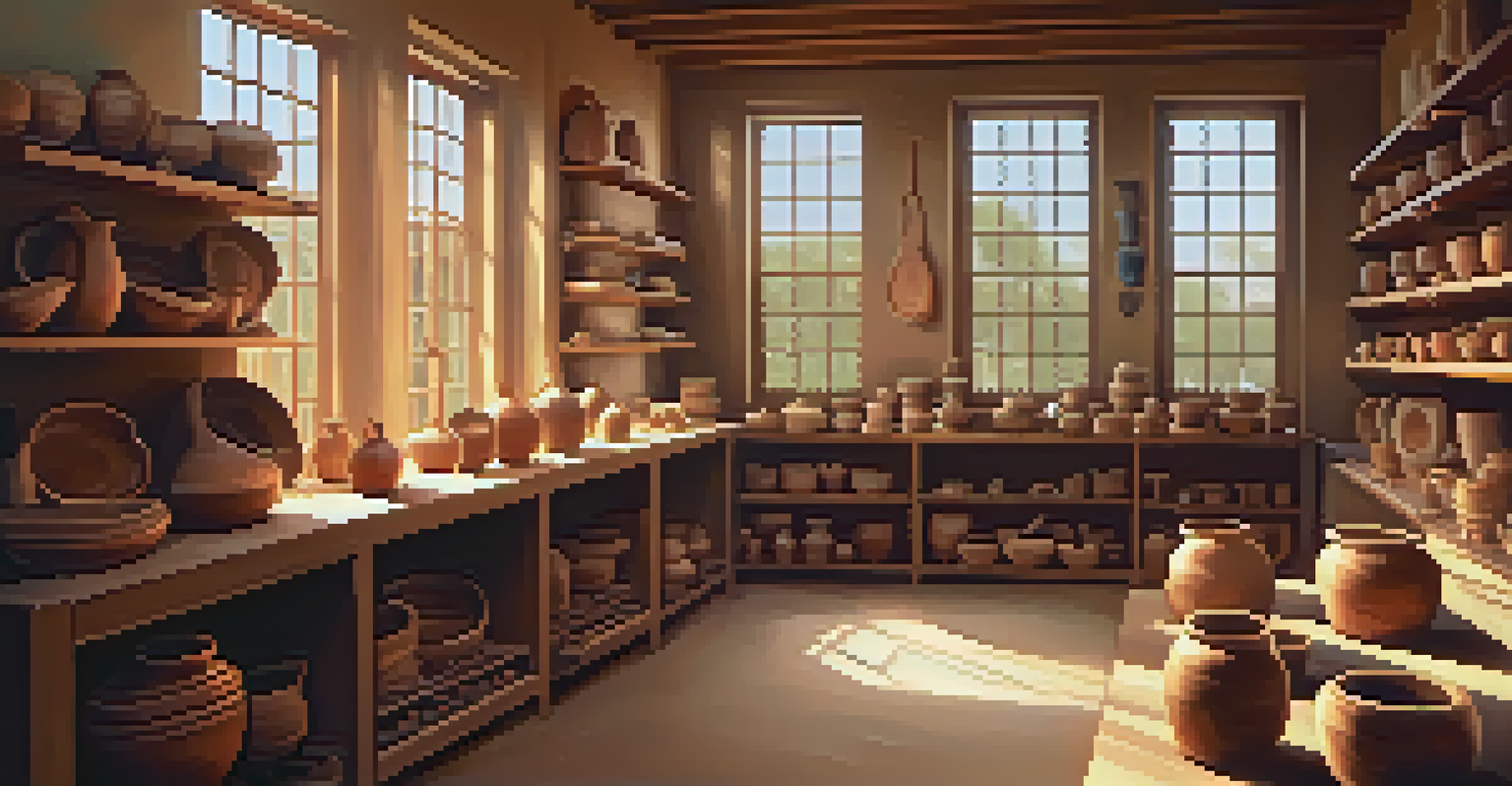Exploring the Rich Traditions of Local Pottery Artisans

The Historical Roots of Pottery in Local Cultures
Pottery has been a vital part of human culture for thousands of years, serving both practical and artistic purposes. Each region boasts unique styles that reflect its history and environment, from the intricate designs of ancient Greece to the rustic charm of Native American pottery. These historical techniques often blend with modern innovations, creating a rich tapestry of tradition and creativity.
Pottery is a way of life, a way of seeing, and a way of being in the world.
In many cultures, pottery isn't just about making bowls or vases; it's a storytelling medium. Each piece often carries symbols, patterns, or colors that reflect the beliefs, myths, and everyday life of the community. For instance, the vibrant colors of Mexican Talavera pottery speak volumes about the region's rich heritage and artistic flair.
As we explore local pottery artisans today, we can appreciate how their work connects us to our ancestors and their traditions. This connection to history not only enriches our appreciation of the art form but also encourages us to support local artisans who keep these traditions alive.
The Artisans: Masters of Their Craft
Local pottery artisans are often passionate individuals who have dedicated years to perfecting their craft. Many learn the art through family traditions, passing down techniques from one generation to the next. This commitment to craftsmanship is evident in every piece they create, showcasing both skill and creativity.

For example, an artisan in a small village may spend hours shaping clay by hand, ensuring each curve and angle reflects their artistic vision. The meticulous process of glazing and firing adds another layer of complexity, where trial and error can lead to stunning results or unexpected surprises. It's this dedication that makes each piece unique.
Pottery Connects to Cultural Heritage
Pottery serves as a storytelling medium, reflecting the beliefs and traditions of various communities.
Moreover, artisans often draw inspiration from their surroundings, incorporating local materials and motifs into their work. This not only fosters a sense of community but also helps preserve local identity, as each piece becomes a reflection of the artisan's environment and story.
The Techniques Behind Pottery Making
Pottery making involves several techniques, each with its own charm and challenges. Hand-building, wheel-throwing, and slip-casting are some of the most common methods that artisans use to shape clay into beautiful objects. Each technique requires a different skill set, allowing artisans to express their creativity in various ways.
The craft of pottery is a bridge between the past and present, carrying the weight of history while embracing the creativity of today.
For instance, hand-building allows for more organic shapes and personalized designs, while wheel-throwing offers precision and symmetry. Many artisans combine these techniques, creating hybrid pieces that showcase their versatility. This blend of methods not only enhances their artistic palette but also keeps the craft dynamic.
Additionally, the type of clay and the firing process can significantly influence the final product. Different clays have unique properties, leading to varying textures and colors after firing. This experimentation with materials is what keeps the art of pottery exciting and ever-evolving.
Cultural Significance of Pottery
Pottery is not just an art form; it holds deep cultural significance in many communities. It often plays a role in rituals, celebrations, and daily life, serving as both functional items and symbols of identity. For example, in some cultures, pottery is used in traditional ceremonies, marking important life events.
Furthermore, the designs and motifs found on pottery often carry specific meanings. They can represent community values, natural elements, or historical events. This imbues each piece with a story, making it more than just an object but a vessel of cultural heritage.
Artisans Preserve Craft Traditions
Local pottery artisans dedicate years to perfecting their skills, often passing down techniques through generations.
As we engage with local pottery, we can better understand and appreciate the diverse cultures that influence these artisans. Supporting their work not only sustains the craft but also helps preserve the rich narratives embedded in each piece.
Modern Innovations in Pottery Art
While traditional techniques remain at the heart of pottery, modern innovations are making waves in the field. Many artisans are experimenting with new materials, tools, and technologies, such as 3D printing, to create unique designs that push the boundaries of conventional pottery. This blending of old and new keeps the art form fresh and exciting.
Additionally, contemporary pottery often reflects modern themes and societal issues, providing a platform for artisans to express their views. For instance, some pieces may address environmental concerns by incorporating recycled materials or promoting sustainable practices. This conscious approach resonates with today's consumers, who are increasingly looking for meaningful art.
Artisans are also leveraging social media and online marketplaces to reach wider audiences, showcasing their work and connecting with customers around the globe. This not only helps them grow their business but also fosters a community of pottery lovers who appreciate the craft.
The Role of Community in Pottery
Community plays a crucial role in the world of pottery, as artisans often collaborate and share ideas with one another. Local workshops and pottery classes create spaces for learning and creativity, where beginners can connect with seasoned artisans. This sense of camaraderie helps nurture the craft and build lasting relationships.
Events like pottery fairs and exhibitions also foster community spirit, allowing artisans to showcase their work and engage with potential buyers. These gatherings are more than just markets; they celebrate the artistry and passion behind pottery, drawing in enthusiasts and curious visitors alike.
Support Local Artisans for Impact
Purchasing from local pottery artisans not only provides unique art but also sustains their craft and community.
Furthermore, community support can have a significant impact on an artisan's journey. By purchasing locally made pottery, consumers play a vital role in sustaining these traditions and empowering artisans to continue their craft.
How to Support Local Pottery Artisans
Supporting local pottery artisans can be as simple as exploring local shops or artisan markets. By purchasing their work, you're not only acquiring a unique piece of art but also contributing to the livelihood of the artisans. This experience also allows you to learn more about the story behind each piece, making your purchase even more meaningful.
Additionally, consider attending pottery workshops or classes. These experiences not only enhance your appreciation for the craft but also provide a platform for artisans to share their knowledge and skills. Engaging with the community in this way fosters connections and helps keep the tradition alive.

Lastly, sharing your love for local pottery on social media can help raise awareness and support for artisans. By showcasing their work and sharing their stories, you contribute to a growing community that values and celebrates the art of pottery.